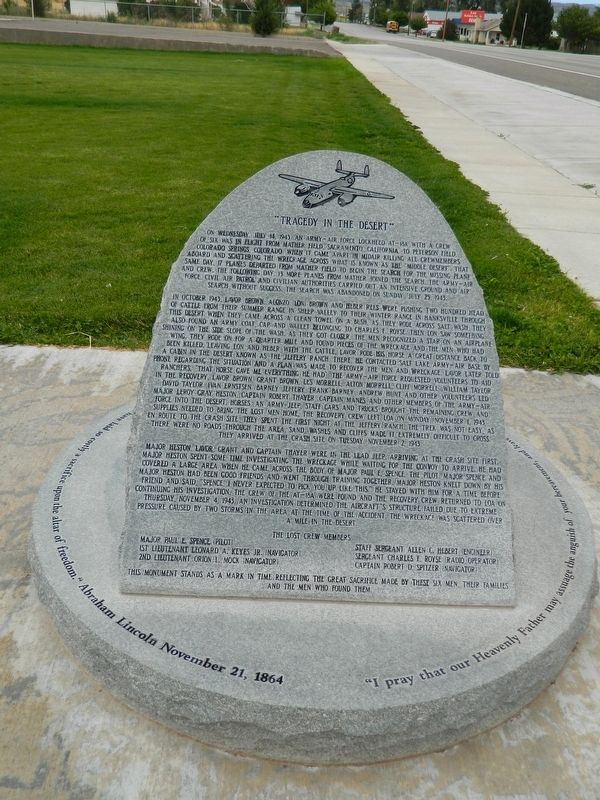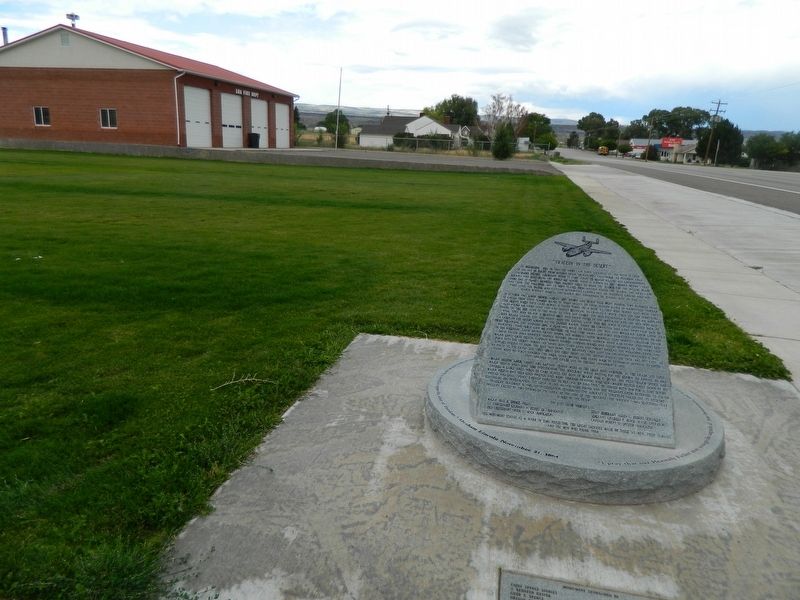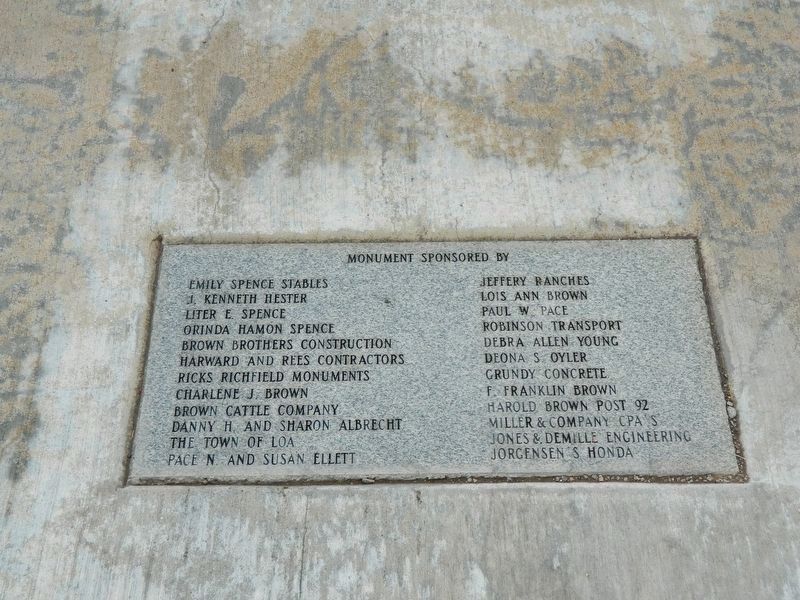Loa in Wayne County, Utah — The American Mountains (Southwest)
"Tragedy in the Desert"
On Wednesday, July 14, 1943, an Army-Air Force Lockheed AT-18A with a crew of six was in flight from Mather Field, Sacramento, California, to Peterson Field Colorado Springs, Colorado, when it came apart mid air killing all crewmembers aboard and scattering the wreckage across what is known as the "Middle Desert". That same day, 17 planes departed from Mather Field to begin the search for the missing plane and crew. The following day, 13 more planes from Mather joined the search. The Army-Air Force Civil Air Patrol and civilian authorities carried out an intensive ground and air search without success. The search was abandoned on Sunday, July 25, 1943.
In October 1943, Lavor Brown, Alonzo (Lon) Brown and Heber Rees were pushing two hundred head of cattle from their summer range in Sheep Valley to their winter range in Hanksville through this desert when they came across a clean towel on a bush. As they rode across Salt Wash, they also found an Army coat, cap, and wallet belonging to Charles F. Royse. Then Lon saw something shining on the side slope of the wash. As they got closer, the men recognized a star on an airplane wing. They rode on for a quarter mile and found pieces of the wreckage and the men who had been killed. Leaving Lon and Heber with the cattle, Lavor rode his horse a great distance back to a cabin in the desert known as the Jeffery Ranch. There, he contacted Salt Lake Army-Air Base by phone regarding the situation and a plan was made to recover the men and wreckage. Lavor later told ranchers, "That horse gave me everything he had". The Army-Air Force requested volunteers to aid in the recovery. Lavor Brown, Grant Brown, Les Morrell, Alton Morrell, Cliff Morrell, William Taylor, David Taylor, Ivan Ernstsen, Barney Jeffrey, Frank Barney, Andrew Hunt and other volunteers led Major Leroy Gray Heston, Captain Robert Thayer, Captain Manes and other members of the Army-Air Force into the desert. Horses, an Army jeep, staff cars and trucks brought the remaining crew and supplies needed to bring the lost men home. The recovery crew left Loa on Monday, November 1, 1943. En route to the crash site, they spent the first night at the Jeffery Ranch. The trek was not easy, as there were no roads through the area. Sand, washes and cliffs made it extremely difficult to cross. They arrived at the crash site on Tuesday, November 2, 1943.
Major Heston, Lavor Grant and Captain Thayer were in the lead jeep, arriving at the crash site first. Major Heston spent some time investigating the wreckage while waiting for the convoy to arrive. He had covered a large area when he came across the body of Major Paul E. Spence, the pilot. Major Spence and Major Heston had been good friends and went through training together. Major Heston knelt down by his friend and said: "Spence, I never expected to pick you up like this." He stayed with him for a time before continuing his investigation. The crew of the AT-18A were found and the recovery crew returned to Loa on Thursday, November 4, 1943. An investigation determined that the aircraft's structure failed due to extreme pressure caused by two storms in the area at the time of the accident. The wreckage was scattered over a mile in the desert.
The Lost Crew Members
Major Paul E. Spence (Pilot)
Staff Sergeant Allen C. Hebert (Engineer)
1st Lieutenant Leonard A. Keyes Jr. (Navigator)
Sergeant Charles F. Royse (Radio Operator)
2nd Lieutenant Orion L. Mock (Navigator)
Captain Robert D. Spitzer (Navigator)
This monument stands as a mark in time reflecting the great sacrifice made by these six men, their families and the men who found them.
Erected 2017 by Concerned Citizens and Organizations.
Topics. This memorial is listed in these topic lists: Air & Space • Disasters • War, World II. A significant historical date for this entry is July 14, 1943.
Location. 38° 24.15′ N, 111° 38.579′ W. Marker is in Loa, Utah, in Wayne County. Memorial is at the intersection of North Main Street and West Center Street, on the right when traveling east on North Main Street. This is part of a Veterans Park. Touch for map. Marker is in this post office area: Loa UT 84747, United States of America. Touch for directions.
Other nearby markers. At least 8 other markers are within 4 miles of this marker, measured as the crow flies. First Wayne Stake Tithing Office (about 500 feet away, measured in a direct line); Loa Tithing Office (about 500 feet away); Loa, Utah (about 500 feet away); The First Grave (approx. 2 miles away); Allred Point (approx. 2.2 miles away); First Public Building (approx. 3.9 miles away); The First Sawmill (approx. 3.9 miles away); Fremont Park (approx. 4 miles away). Touch for a list and map of all markers in Loa.
Regarding "Tragedy in the Desert". This marker is in regards to a military plane crash in 1943 and the subsequent recovery efforts.
Also see . . .
1. Loa Utah, Wikipedia page. Information regarding the Town of Loa, Utah (Submitted on September 21, 2019, by Thomas Onions of Olathe, Kansas.)
2. Lockheed Hudson. Wikipedia entry regarding the plane involved in the tragedy. (Submitted on September 21, 2019, by Thomas Onions of Olathe, Kansas.)
3. Small southern Utah town to honor 6 killed in 1943 military plane crash. (Submitted on October 6, 2019, by William Fischer, Jr. of Scranton, Pennsylvania.)
Credits. This page was last revised on October 6, 2019. It was originally submitted on September 21, 2019, by Thomas Onions of Olathe, Kansas. This page has been viewed 467 times since then and 58 times this year. Photos: 1, 2, 3. submitted on September 21, 2019, by Thomas Onions of Olathe, Kansas. • J. Makali Bruton was the editor who published this page.


